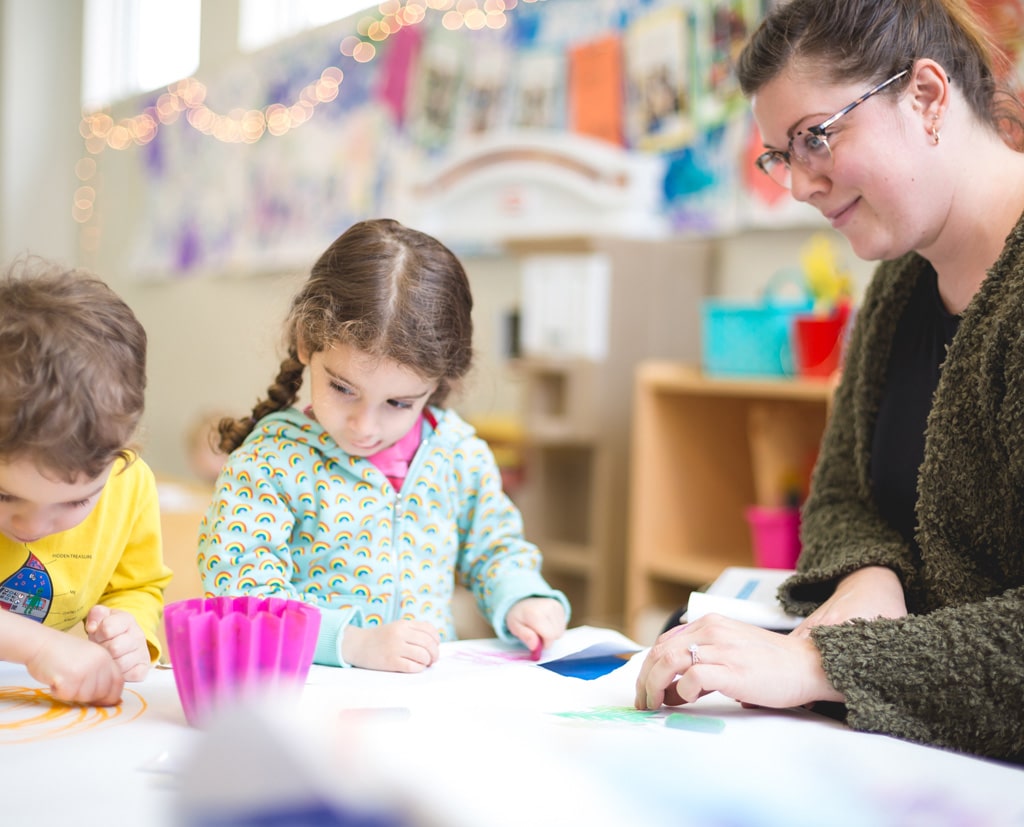In the phases of early childhood development, children explore the world around them. A child dropping, throwing, handling, squeezing, and making a mess are cornerstones of toddler growth and development. Preschoolers must experience diverse materials, sensations, and substances hands-on rather than merely hear about them.
When children engage with toys and other items with their hands, they use their sense of touch to learn about it and its place in their growing world. At Bubbles Academy, we frequently use sensory play to satisfy our students’ endless curiosity. Let’s delve into how hands-on experiences help your child reach preschool learning milestones.
What Does Hands-On Learning Mean?
Hands-on refers to a child using their hands to learn about different items. Sensory play, a broader term for hands-on, involves the child using all five senses to engage in an activity. During the earliest developmental stages in infants, you’ll notice that they use their hands and fingers to gain awareness of their body parts.
As your child grows, they need more complex sensory activities to help them discover how the world surrounding them works. You’ll find some examples of sensory activities below.
Types of Hands-on Learning
One of the most enjoyable characteristics of hands-on learning is the endless possibilities at your child’s fingertips — literally! Most sensory play falls into one of the following six categories:
- Tactile: Your child uses their hands to touch and feel an object. They become more aware of texture, temperature, hardness, and more.
- Vestibular: This type of play helps your child understand how their body moves. They learn about gravity and their weight through running, jumping, and rolling.
- Proprioception: Proprioception pairs well with vestibular activities. Where vestibular play helps them learn how their body moves, proprioception assists with spatial awareness.
- Auditory: Don’t fret if your child loves to make a racket! The noise helps them learn about different sounds through auditory play.
- Visual: Your child learns how an object’s appearance connects with how it feels and moves through space.
- Taste and Olfactory: Taste connects with smell. Sometimes, they will learn that smell does not influence taste. For example, delicious, cherry-scented shampoo doesn’t taste like cherries.
How Hands-On Learning Benefits Early Childhood Development
While sensory play and hands-on learning help your child engage their senses, they also play an essential role in how your child grows with the world surrounding them. They encourage holistic child growth, preparing preschoolers for social, physical, emotional, and mental changes.
Have Real, Applicable Experiences
Part of early childhood education involves teaching skills your child will use as they grow. Sensory play helps them develop and fine-tune their capabilities in various areas. These abilities are essential for basic activities like walking or cooking a meal as an adult.
Interact With the Environment
Sensory play doesn’t just teach your child about themself and their toys. It also shows them how other things, like trees, animals, and people, fit within the world.
Use All Five Senses
Each of the five senses has a vital role in securing our survival as a species. When your child knows how to use them, they can identify dangerous things vs. helpful or nutritious items.
Exercise Various Parts of the Brain
All parts of the human brain need exercise to work harmoniously. Sensory play allows your child’s brain to create connections, grow, and build strength.
Have More Fun
Adults can have fun with sensory play, too! Join your child in their discovery journey. Engage your senses alongside your little one throughout each activity.
Examples of Vehicles for Hands-On Learning
What methods can you use to encourage child cognitive development through sensory play at home? Discover some creative vehicles to elevate early childhood development:
- Blocks: Block sets help your child develop their proprioception while engaging them with bright colors and fun shapes.
- Playdough: Your child can use their tactile skills to mold letters, numbers, and original characters.
- Simon Says: This classic game challenges your child’s vestibular and proprioception capabilities.
- Obstacle courses: Your child will learn how to move through the course using visual, proprioception, and vestibular play.
- Sensory books: Many children’s books have a wealth of sensory opportunities, like diverse textures, engaging noises, and vivid colors paired with corresponding words.
- Coloring books: Engage your child’s visual sense by asking them to fill a page from a coloring book.
- I Spy: This game works great for car rides, long lines, and other boring situations. It challenges your child to match objects with your descriptions.
- Touch and feel games: Shopping trips and nature hikes offer multiple opportunities to learn how different objects feel. Join your child in touching fabrics, items you plan to purchase, and natural materials.
Explore Hands-On Learning Opportunities at Bubbles Academy
The staff at Bubbles Academy has a passion for early childhood development. We are your child’s first step into the world beyond their home. Call 312-944-7677 to enroll or register with us online.

